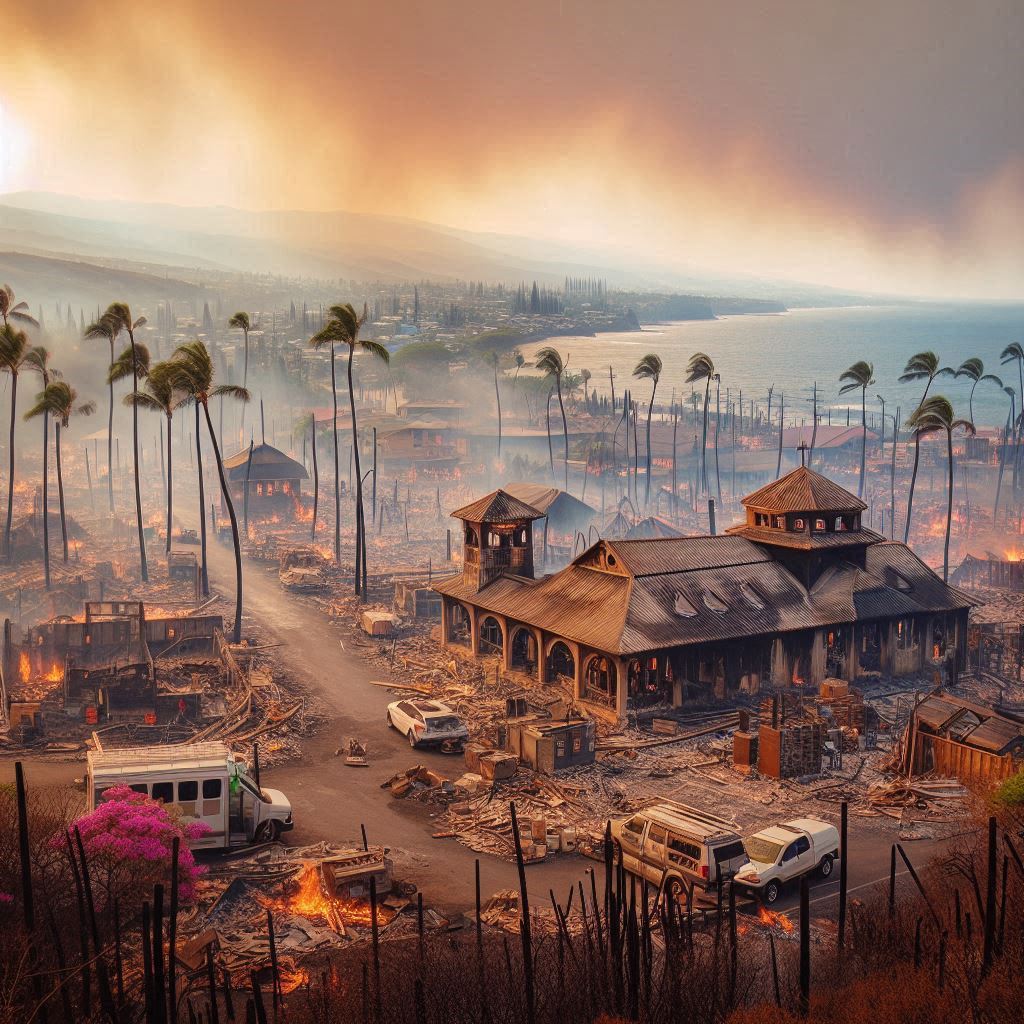The Lahaina Fire represents one of the most devastating events in recent memory for Lahaina, a historic and culturally significant town on Maui, Hawaii. Known for its beautiful beaches, vibrant streets, and rich heritage, Lahaina was abruptly engulfed by flames, leading to unprecedented destruction. This comprehensive overview examines the origins and spread of the fire, its immediate and long-term impacts, and the collective response to this tragedy. From the human toll to the environmental damage and recovery efforts, this guide aims to provide a thorough understanding of the fire’s consequences and the ongoing journey towards rebuilding.
What Was the Lahaina Fire?
The Lahaina Fire comprised a series of wildfires that ravaged the town of Lahaina. Although wildfires are less common in Hawaii compared to regions like California or Australia, this disaster unfolded with startling intensity. The fire quickly consumed homes, businesses, and natural landscapes, reducing a thriving community to ruins. Lahaina’s historical significance, including its role as the former capital of the Hawaiian Kingdom, compounded the tragedy, as the loss affected not only the local populace but the broader Hawaiian heritage.
The Origin of the Lahaina Fire
The Lahaina Fire’s origins are linked to a mix of natural and human factors. During a particularly dry season, extreme heat and parched vegetation created a highly flammable environment. Strong trade winds, typical of the region but unusually intense, accelerated the fire’s spread. While investigations are ongoing, preliminary reports suggest that improperly managed brush and an accidental spark might have ignited the blaze. The combination of dry conditions and strong winds turned what could have been a controllable fire into a raging inferno, challenging even the most prepared firefighting teams.
The Speed of the Fire’s Spread
One of the most alarming aspects of the Lahaina Fire was its rapid spread. Driven by high winds, the fire surged across Lahaina with alarming speed, leaving little time for residents to react. Eyewitnesses describe receiving emergency alerts only to find the fire perilously close. In some cases, families had mere minutes to evacuate, grabbing essential belongings before fleeing. The fire’s speed, reportedly reaching up to 20 miles per hour, overwhelmed local emergency services, compounding the crisis.
Immediate Impact on Lahaina
The immediate aftermath of the Lahaina Fire was catastrophic. Thousands were displaced, and entire neighborhoods, including Front Street—a vital cultural and economic hub—were devastated. The destruction of businesses not only impacted individual owners but also dealt a severe blow to Lahaina’s economy, which relies heavily on tourism. In addition to the economic fallout, the fire caused widespread emotional trauma, with families losing homes and treasured possessions. Essential services like power, water, and communications were disrupted, exacerbating the community’s suffering. Emergency shelters were quickly established, and neighboring communities rallied to provide aid.
The Human Toll: Lives Lost and Injured
The human cost of the Lahaina Fire was profoundly tragic. Lives were lost, including elderly residents who could not evacuate and individuals who perished while trying to protect their property. Many others suffered injuries while fleeing the flames. Stories of bravery emerged, with neighbors and first responders risking their lives to save others. The grief from the loss of loved ones and the emotional scars from the disaster will endure long after physical rebuilding is complete.
Environmental Damage

The environmental impact of the Lahaina Fire was severe. The blaze destroyed thousands of acres of vegetation, altering the landscape and damaging ecosystems. Wildlife habitats were lost, leading to a decline in local biodiversity. The fire also affected the soil, increasing the risk of erosion and landslides. Ash and debris pose a potential threat to local water sources, complicating the recovery process. Restoration efforts will require significant reforestation, soil rehabilitation, and wildlife conservation.
Economic Impact on the Region
The economic ramifications of the Lahaina Fire extend beyond the immediate damage. As a key tourist destination, Lahaina’s destruction halted tourism, leaving many without jobs and impacting the broader Maui economy. The loss of infrastructure further hampers recovery, and rebuilding will require substantial financial investment. While insurance claims and government aid provide some relief, the road to economic recovery will be long and challenging.
Response and Control Efforts
Firefighters and emergency responders faced a formidable challenge in combating the Lahaina Fire. High winds and the fire’s sheer scale complicated containment efforts. Despite round-the-clock work, including aerial water drops, the fire continued to spread. Reinforcements from other islands and the mainland were eventually brought in. The dedication of firefighters was evident, but the fire’s magnitude presented a nearly insurmountable obstacle.
Community Support and Recovery
In the wake of the disaster, the Lahaina community has demonstrated remarkable resilience. Local organizations, churches, and volunteers mobilized quickly to provide essential supplies and shelter. The outpouring of support from both locals and people around the world has been overwhelming. Social media played a vital role in coordinating relief efforts and fundraising, highlighting the strength and unity of the community in the face of adversity.
Government Assistance and Aid
Recognizing the scale of the disaster, both local and federal governments have provided substantial aid. Emergency funds have been allocated for immediate needs, including temporary housing and medical care. FEMA and other disaster relief teams have assisted with cleanup and rebuilding. Despite some frustrations with the bureaucratic process, the government’s support has been crucial in beginning the recovery phase.
Rebuilding and Moving Forward
Rebuilding Lahaina will be a monumental task, requiring extensive financial and emotional investment. Decisions will need to be made about whether to rebuild or relocate. The rebuilding process will incorporate lessons learned from the fire, including updated building codes and improved fire management practices. The goal is to restore Lahaina while enhancing its resilience to future disasters.
Lessons Learned
The Lahaina Fire has highlighted the importance of disaster preparedness and effective fire management. The rapid spread of the fire underscores the need for better early warning systems and evacuation plans. The disaster has also sparked discussions about climate change and its impact on wildfire frequency and severity. The lessons learned from this event will inform future disaster response and preparedness efforts globally.
Global Awareness and Support
The international response to the Lahaina Fire has been profound. Donations and support have poured in from around the world, raising millions for recovery efforts. Celebrities, businesses, and organizations have helped raise awareness and mobilize aid. This global solidarity not only supports Lahaina but also emphasizes the need for cooperative action in addressing climate change and wildfire risks.
Conclusion
The Lahaina Fire was a tragedy of immense proportions, leaving deep scars on the town and its people. The resilience of the Lahaina community and the global support received offer hope for recovery. As the town rebuilds, the lessons learned from this disaster will help strengthen future preparedness and response strategies. The enduring spirit of Lahaina, coupled with the support from around the world, will guide its journey from devastation to recovery.
FAQs
What caused the Lahaina Fire?
The exact cause is under investigation, but it is believed to be a mix of human error and natural conditions, such as dry vegetation and strong winds.
How fast did the Lahaina Fire spread?
The fire spread rapidly, with reports indicating speeds of up to 20 miles per hour due to high winds and dry conditions.
What was the impact on the environment?
The fire caused extensive environmental damage, including the destruction of vegetation, loss of wildlife habitats, and increased erosion risk.
How is the community recovering?
The community is recovering with the help of local organizations, volunteers, and government aid, providing essential relief and support to those affected.
What lessons were learned from the Lahaina Fire?
The fire highlighted the need for better disaster preparedness, fire management, and awareness of climate change impacts on wildfire risks.
- Key Nutrients Your Immune System Actually Relies On (And Where to Get Them)
- Prepping Your Home Exterior Before Winter Weather Hits
- Exploring the Dark Beauty: Unveiling the Meaning and Symbolism Behind Angel of Death Tattoos
- 50 gangster side neck tattoos for guys
- Zealpozold Brand Review (2025): Benefits, Ingredients, and Global Popularity Explained






